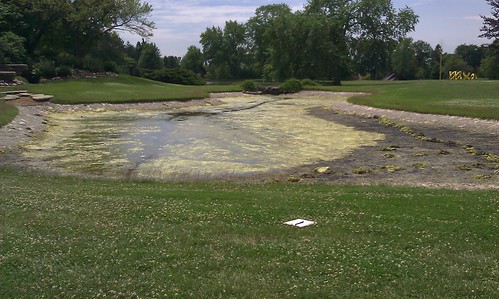An Elephant Sneezed into Our Little Lake…Or, Why Is the Little Lake Dry? pt. 2
Last fall we drained the Little Lake, harvested the algae from the bloom , and used it for compost and papermaking. In the late spring we removed as much algae as we could and refilled the pond for the summer season and invited Christine to make a plan to control the bloom. At Lynden, we are constantly balancing the aesthetic imperative—our desire to maintain the landscape that Peg and Harry Bradley created—with out commitment to sustainability. Large buffer zones and aggressive aquatic plantings might make a bigger dent in the algae problem, but they would also radically alter the look of the pond and the area around it. With this in mind, and with lots of consultation with Lynden staff, Christine developed a plan.
II.
What can be done to control algae blooms?
Small ponds pose one of the biggest challenges to management but I have proposed a number of measures that are in the process of being approved and implemented. Elimination of lawn fertilization has been in place for a few years and will help to reduce nutrient run-off into the basin. Here are the highlights of the proposed plan that will help to reduce the prevalence of algae blooms:
1. Drain and dredge the lake. Dredging the lake will take place once the lake is drained and consists of removing the existing pea gravel and a portion of the sediments. This will remove some of the nutrients from the system in addition to some algae spores.
2. Submerge barley straw. Hydrogen peroxide and other enzymes/chemicals are released when barley straw decomposes in the presence of oxygen. The decomposition products inhibit algal growth, but do not kill existing cells.
3. Install a reciruculating pump. A recirculating pump will allow for continuous movement of water and help to discourage surface bloom formation while maintaining a more uniform oxygen concentration. The pump will encourage decomposition of the barley straw and will, with the help of the wind, circulate the products of decomposition throughout the basin. It will also enable us to run the waterfall on a regular basis!
4. Shoreline restoration.
Phase 1: Aquatic plants. Emergent aquatic plants will trap nutrients while shading the lake bottom, thereby reducing the surface area on which benthic (bottom-loving) algae can grow. These plants not only provide essential habitat for wildlife (frogs, turtles, some birds), but also stabilize the shoreline and provide a barrier to the organic matter that blows in from the lawn.
Phase 2: Shoreline plants. Plants that grow along the shoreline are adapted to wet or moist soils. Like emergent aquatic plants, shoreline plants encourage wildlife (birds and butterflies), stabilize the shoreline (they have deeper root systems than lawn turf) and help to block terrestrial organic matter. Moreover, geese are less likely to “hang out” by a shoreline where predators lurk.
Care will be taken to use plants native to Wisconsin, and which were raised in Wisconsin, to
maintain the ecological integrity of Little Lake.
- Polly's blog
- Login to post comments

